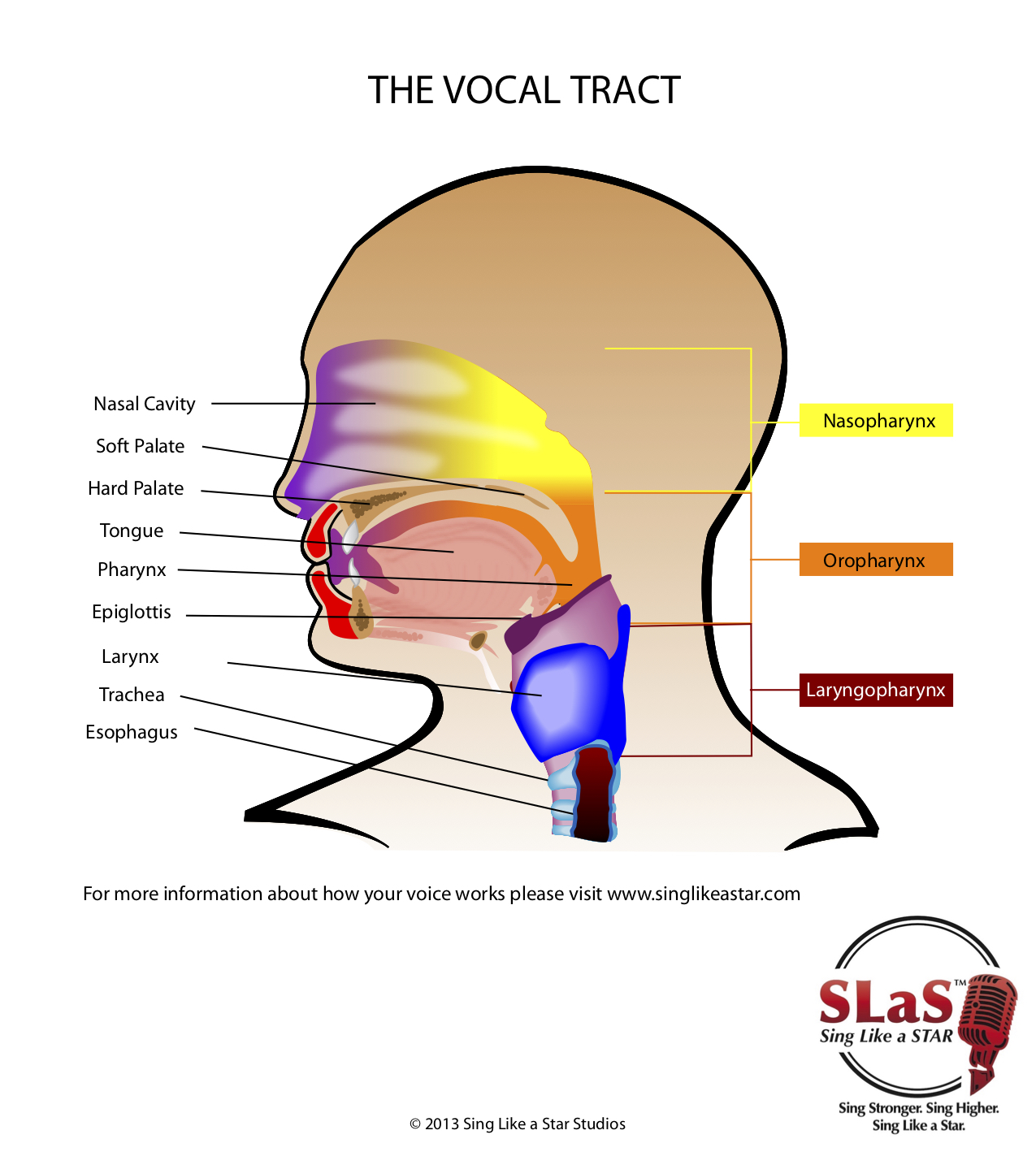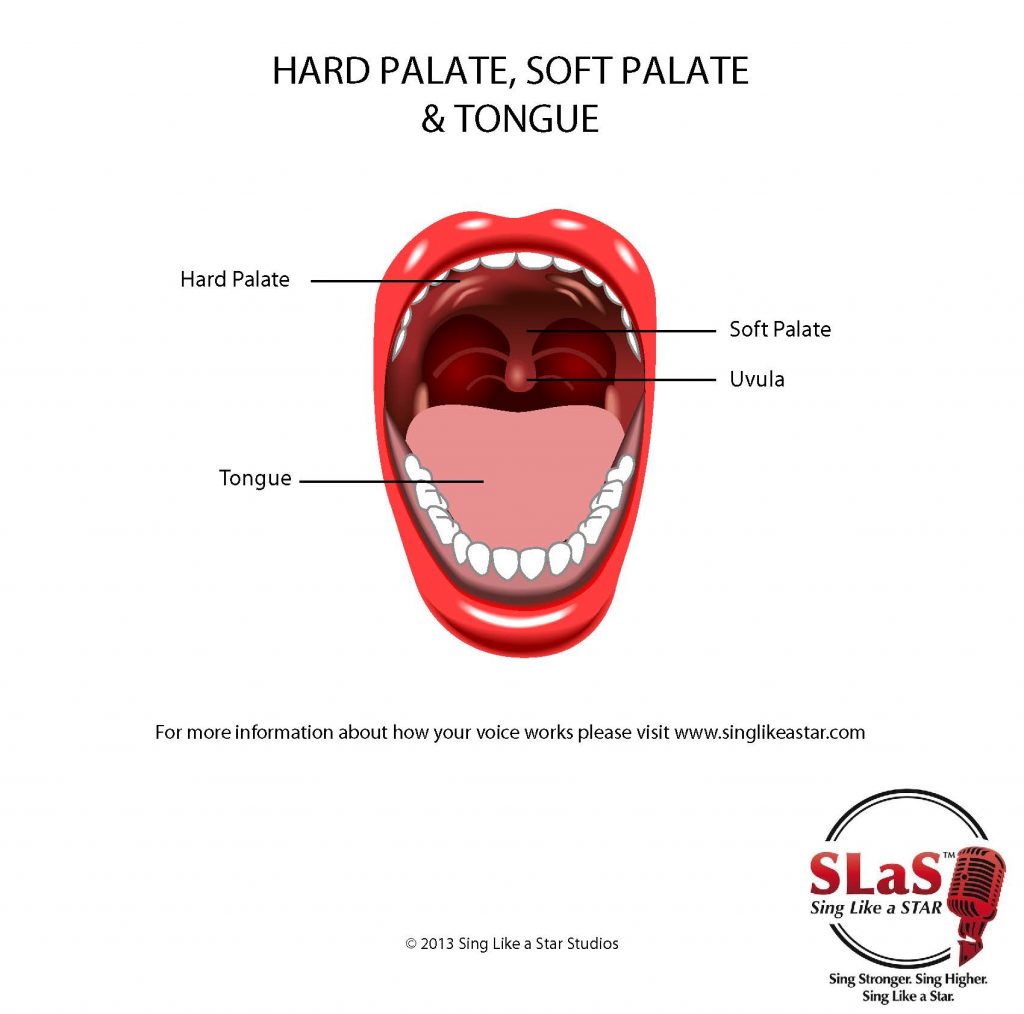How to Sing Better: Resonance in Singing


Resonance happens in the vocal tract- the cavities of the pharynx and mouth. This is where the buzz-like basic voiced sound is transformed through the magic of formants and harmonics interacting with each other. The vocal tract includes the pharynx (where the larynx resides, known as the laryngopharynx), the mouth and, to a smaller extent, the nasal cavities or nasopharynx. The mouth and pharynx are where partials are filtered and selectively boosted or attenuated (damped).

RESONATOR 1: THE PHARYNX
The pharynx is more commonly known as the throat. This is the first “container” that an energized airwave encounters before traveling up to the oral cavity. The role of the pharynx is to filter and selectively boost some partials and to dampen or attenuate others.
The size of this resonating tube can be altered by movements of the larynx, which increases or decreases the tube length. This, in turn, alters formant and harmonic relationships. The pharynx takes up the area of about three to four inches above the vocal folds and is divided into three sections:
1. The nasopharynx (sometimes called the nasal pharynx) is the area behind the nasal cavity extending from the base of the skull to the soft palate. It is the highest area of the pharynx, located above the mouth and behind the nose. The nasopharynx is the largest open space of the three pharyngeal areas and is the most fixed. The Eustachian tubes open into the nasopharynx, making it the path connecting our vocal sound to the ear internally. For most singing, the nasopharynx is not a resonator since it is closed off when the soft palate is raised; however, the nasopharynx is employed when creating the French Nasal vowels and nasal consonants such as M, N, or NG. Lowering the soft palate creates a more nasal tone quality as air is diverted into the nasal cavities.
2. The oropharynx, located straight behind the mouth. The oropharynx is made up of predominantly soft tissue and extends from the uvula to the epiglottis. If you open your mouth wide and look in the mirror to the back of the mouth, you will be looking at the oropharynx. The oropharynx should be relaxed and free from tension when singing.
3. The laryngopharynx also known as the hypopharynx, begins below the epiglottis and connects down to the esophagus. Beginning immediately above the vocal folds, the laryngopharynx is the first space that the larynx opens into. It extends from the larynx itself up to the oropharynx behind the mouth. The laryngopharynx is affected by the relative positioning of the larynx, which is moveable.
The larynx can assume a low, neutral, or high position, depending on the activity of extrinsic muscles. When the larynx is high, the extrinsic suprahyoid elevator (swallowing) muscles have engaged to pull the larynx up. This happens whenever we swallow food or drink, as part of a protective action that closes the glottis and prevents the material from getting into the trachea (breathing tube). While this is great for eating and drinking, we do not want to activate this sphincter action when singing.
We counteract the suprahyoid elevator muscles’ hiking of the larynx by vocalizing on imposed larynx sounds that we call dopey, dumb, woofy, etc. These exercises activate the infrahyoid depressor muscles.
For good singing, the larynx should be stable (not rising along with ascending pitch) and relaxed. Various vocal styles may require higher or lower larynx positions; however, a good starting place is the comfortable position the larynx assumes as you take a relaxed breath.
RESONATOR 2: THE MOUTH
The mouth is the second “container”. The role of the mouth is to filter and selectively boost some partials and to dampen or attenuate others. The mouth contains the tongue, an articulator that moves to form vowel shapes. The constriction or hump of the tongue is responsible for dividing the mouth and pharynx.
RESONANCE AND THE SOFT PALATE
Just behind the top teeth is the immovable roof of the mouth, called the hard palate. Behind the hard palate is the soft palate or velum, which moves up and down. The uvula (the little dingle you can see hanging down in the back) is attached to the soft palate. The velum is composed of mucous membranes, muscle fiber, and mucous glands. The moveable soft palate and tongue, along with the lips and jaw, form various vocal tract shapes. The soft palate elevates when we yawn and sing hooty sounds; it lowers when we sing nasalized sounds.
The velum or soft palate is responsible for closing off the nasal passages during swallowing and phonation of non-nasal sounds via the velopharyngeal port. The soft palate raises and lowers during speech to separate the mouth (oral cavity) from the nasal cavity. When you inhale, the soft palate rises slightly, allowing more space for airflow.
When the soft palate is high and the tongue and larynx are low, as when we sing an imposed larynx sound, the pharynx resonator is larger and the resulting sound is darker. When the larynx is low or the lips are rounded, both F1 and F2 frequencies are lowered. This means the tone will have more depth or oscuro. Transitioning through the primo passaggio will be easier.
When you inhale as if you are smelling a fragrant rose, the soft palate assumes a slightly more lifted position. This position is known as the incipient yawn. When you complete a yawn, however, the soft palate goes even further up and stiffens. In the completed yawn, the soft palate is tensed too much for singing. When the soft palate is too high and tense, the sound will be dull and lacking in overtones. A soft palate that is slightly raised but relaxed will give you more space in the mouth resonator and a richer, more resonant timbre. However, the soft palate should never be stiffened or lifted too high; it should be flexible to meet the demands of any vocal color.
In the image below the soft palate is lifted a bit as if the singer is just about to yawn. This is the incipient yawn that produces a richer tone quality.

If you would like to learn more about your voice AND learn to sing from home for less than you probably spend for lattes every month, check out our amazing YOU can Sing Like a Star online subscription courses for singers and voice teachers.
You can learn to sing with a self-study method- IF it's the right method. The ONLY method that can take you from beginner to professional is the YOU can Sing Like a Star online subscription course with over 600 recorded exercises.
This is the best method available and the ONLY method that takes you all the way from beginner to professional singer- for far less than the cost of in-person voice lessons!
Check this amazing course out at YOU can Sing Like a Star online subscription course.
If you are a voice teacher who wants to up your game, check out the YOU can be a Successful Voice Teacher online subscription course
With over 600 recorded exercises, including Riffs and Runs- Style, you don't need to be a great pianist or vocal stylist to be a great teacher!



